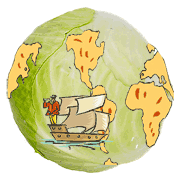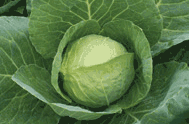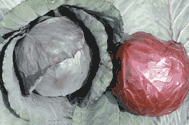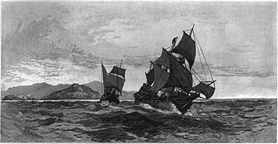
Captain Cook's love affair with cabbage
If he were alive today, he'd say, "Ahoy, there! Grow this vegetable today!"
Hosted by Marion Owen, Fearless Weeder for PlanTea, Inc. and
Co-author of Chicken Soup for the Gardener's Soul
FEATURE ARTICLE:

Tom Hanks' "Power of Four" solution
More good stuff:
Who is Marion Owen?
FAQs about PlanTea
Search Marion's articles, tips and recipes
Why grow organic?
News and press releases
Read love letters
How to link to this site
Need a speaker?
How to contact Marion
Visiting Alaska?
Come to Kodiak Island!
Go to home page

Marion's UpBeet Gardener
Newsletter has been
replaced by Marion's blog
which you can find at:
www.marionowen.wordpress.com
 During Captain Cook's first voyage, which began in 1768, a mighty storm came up. The ship rolled and pitched violently, and many crewmen were injured. To save the men from gangrene, the ship's doctor made poultices of cabbage to apply to their wounds.
During Captain Cook's first voyage, which began in 1768, a mighty storm came up. The ship rolled and pitched violently, and many crewmen were injured. To save the men from gangrene, the ship's doctor made poultices of cabbage to apply to their wounds.
While the men's injuries were the result of accidents above and below decks, it was no accident that cabbage sailed with Cook during his ten years of world explorations. Cook was one of the first ship captains to recognize that a lack of Vitamin C in a sailor's diet (due mostly to a lack of fresh fruit and vegetables) caused scurvy, a horrible disease that killed many sailors in those times. Thus, Cook always sailed with lots of cabbage, mostly pickled cabbage, which he insisted the sailors eat. Scurvy was never a problem on his ships because the cabbage contained lots of Vitamin C.

Today, we might not slap a cabbage poultice on a child's skinned knee, but cabbage remains a loyal friend nonetheless. It warms us during the chill of winter in steaming soups and savory baked dishes. It refreshes us in summer, its fine slices piled high to make bowls of crunchy coleslaw. Corned beef without cabbage? Unthinkable. And hot dogs? No hot dog could call itself a true hot dog if cabbage were not made into sauerkraut.
Cabbage has been the backbone and sustenance of many cultures for thousands of years, though we often think of cabbage as a plain, end-of-the-line vegetable for folks that live in cold climates. Yet cabbage and its many cousins like kale and broccoli are grown around the world. And it's because of this adaptability, the National Gardening Association chose cabbage as one of their Plants of the Year for 2007.
Cabbage is one of the most hardy, nutritious and in my opinion, one of the most beautiful vegetables a home gardener can grow. If you take in the whole cabbage family, it's a gaggle of vegetables. For starters, there are dozens of varieties of cabbage, but this family of cruciferous or brassica vegetables also includes broccoli, collards, Brussels sprouts, cauliflower and kohlrabi.
And cabbage comes in a variety of shapes, sizes and colors: You'll find the tightly-headed red and green cabbages, the longer, looser, crinkled Savoy, and then Napa cabbages. Within these three groups, the choices break down to head shape (round, conical or cone shaped, globe or flat-round) and harvest time (early, mid-season, or late).
+ Early and mid-season varieties include: Primax, Ruby Ball, Gonzales, Charmant and most of the Savoys
+ Late varieties: Late flat Dutch, Danish Ballhead, Roulette
In all, the outer--usually darker--leaves are called wrapper leaves, which is helpful information for cooks. (Remember, the darker the green, the more nutritious it is.) Flat-headed cabbages are best for stuffing. Large, late cabbages are most flavorful and best for sauerkraut.


Cabbage is beautiful! Primax (left); Ruby Perfection (right) from Johnny's Selected Seeds
Eliot Coleman, author of the excellent book, Four-Season Harvest, maintains an extensive organic farm in Maine. He places cabbage high on his list of "grindables," as one of my organic gardening calls vegetables. "Cabbage," extols Eliot, "is a year-round food. We favor red and Savoy cabbage so much that we often don't grow the standard, round, smooth-leaved green cabbage.
"Red cabbage is a vigorous plant, it stores well, and it is the basis for sensational sauerkraut and cooked dishes. Savoy cabbage, with its crinkly green leaves, is by far the most flavorful of the green cabbages either cooked or raw."
Cabbage in every garden! How to grow cabbage...
Cabbage prefers cool weather, tolerates heavier soils and light frost. That said, soil texture isn't too critical, but cabbage is a heavy feeder and does best under fertile conditions in a soil with a neutral pH. Enrich your soil with kelp (seaweed) and compost or well-rotted manure, and side-dress a couple weeks after planting with the same materials.
 As for seedlings, you can buy nursery transplants, but cabbage is easy to grow from seed. Plan to set out early varieties 3 to 4 weeks before the frost-free date. You might be able to sneak in an earlier planting date. To learn how to start plants from seed, read my (easy to follow) seed-starting article.
As for seedlings, you can buy nursery transplants, but cabbage is easy to grow from seed. Plan to set out early varieties 3 to 4 weeks before the frost-free date. You might be able to sneak in an earlier planting date. To learn how to start plants from seed, read my (easy to follow) seed-starting article.
Plant seedlings in the garden slightly deeper than they grew in flats or containers. Make planting holes wide enough to accommodate spread-out roots and press the soil firmly, and I mean firmly, around each seedling. Water thoroughly and keep plants moist during the growing season to prevent heads from splitting.
Space seedlings about 16 inches apart. Normally I don't mention spacing, but it seems to make a difference with cabbage: Wide spacings produce bigger heads, it's true, but young, small cabbages are tastier.
Root maggot pests
While it depends on where you garden, cabbage maggots, also called root maggots, are often the number one pest-headache it comes to growing cabbage. As a preventive measure, always remove plants, roots and all, at season's end. Crop rotation is also important. Never follow where a member of the same family was grown the year before. In other words, don't plant cabbage in the same bed where you grew broccoli last year. Sow lettuce or peas instead.
If your cabbage crop has been hit by root maggots, place a collar made of tar paper or similar flexible material around the stem of each plant so the collar sits flat on the soil. If the invasion was extensive, then cover your whole bed with a floating row cover. I know a gardener in Southeast who keeps her broccoli and cabbage beds covered all summer to prevent the cabbage fly from laying eggs at the base of their plants. "I never see the plants all summer," she says, "but I know my plants are safe."
Cutworms can also cause havoc in the garden. To avoid cutworm damage, place a tuna fish or cat food can (with the top and bottom removed) halfway into the soil to act as a collar for the plant. As for slugs, well, they require more coverage, so to learn more about slugs (and weeding and all kinds of stuff) check out my other articles.
Cabbage plants are gorgeous additions to a perennial or mixed border. If you're in Anchorage, Alaska during the summer, you are likely to see Savoy cabbage growing in planting beds along the city streets next to petunias and geraniums. Also, if you're in the area during the Alaska State Fair in September, don't miss the  The Giant Cabbage Weigh-Off, where very big cabbages often tip the scales at 90-plus pounds. It's one of the most well-known and popular events at the Fair each year.
The Giant Cabbage Weigh-Off, where very big cabbages often tip the scales at 90-plus pounds. It's one of the most well-known and popular events at the Fair each year.
From a cook's and health-conscious perspective, these showy plants are also loaded with iron, folate, beta-carotene, potassium, and phyto-chemicals, such as glucosinolates--proven to reduce cancer, especially lung cancer. NOTE: to learn the nutritional content of hundreds, if not thousands of foods, search the U.S. Department of Agriculture (USDA) database.
Captain Cook was an expert seaman, navigator and scientist, though he didn't know about all that phyto-chemical, gluco, whatever-you-call-it stuff. He realized however, that the success of his voyages depended on the health of his sailors.
And to think he owes it all to cabbage!
Thanks for visiting. I hope you enjoyed this article. Cheers to you!
![]()

Thanks for visiting and please stop by again. I'll put the coffee on!
Meet Marion Owen /// Learn about PlanTea /// Online Catalog /// Articles, Tips, Recipes /// Get free UpBeet Gardener newsletter /// Read current issue /// Listen to radio show /// Read news and press releases /// More resources and links /// Learn why 'grow organic?' /// View guidelines for retailers /// Read love letters /// Book Marion as a speaker /// Site map /// How to link to us /// Contact us /// Go to home page
PlanTea: The organic plant food in tea bags. http://www.plantea.com
Copyright ©1996 to present: PlanTea, Inc. All Rights Reserved. PO Box 1980, Kodiak, AK 99615-1980 USA
Questions or comments? marion@plantea.com Phone: Toll Free: 1-800-253-6331 (US and Canada); 907-486-2500